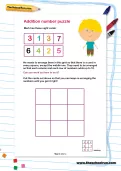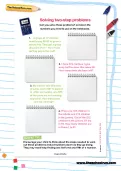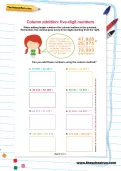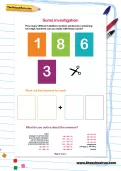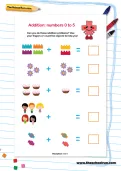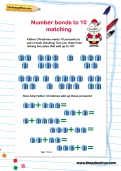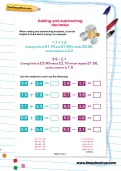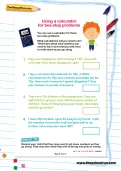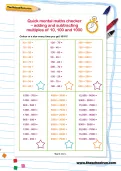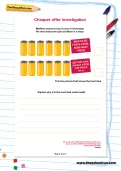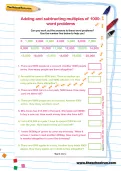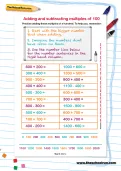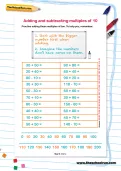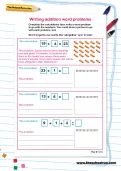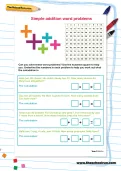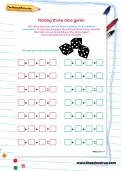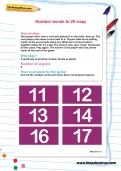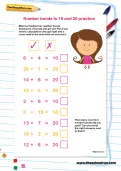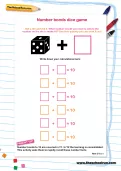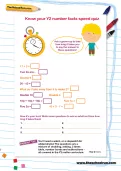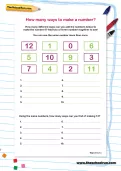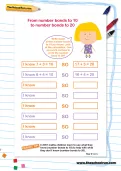Can you do these addition problems? Use your fingers or count the objects to help you!
or
Register to add to your saved resources
Already a subscriber? to view this content.
Father Christmas wants 10 presents to put in each stocking. Can you draw lines linking two piles that add up to 10? This Christmas-themed worksheet will help your child practise number bonds to 10 and simple addition.
or
Register to add to your saved resources
Already a subscriber? to view this content.
When adding and subtracting decimals, it can be helpful to think about money. For example: 1.7 + 1.5. Change this to £1.70 and £1.50 to make £3.20, so the answer is 3.2. Use this method to work out these sums.
or
Register to add to your saved resources
Already a subscriber? to view this content.
You can use a calculator for these two-step problems. What calculations will you need to do? Think hard about what numbers you need to key in and what you will need to write down as you go along.
or
Register to add to your saved resources
Already a subscriber? to view this content.
Can you solve these problems? Jot down the numbers you need to use on the notebooks. Think about the steps needed to work out these problems and jot numbers down as you go along. Ask a parent if you need help finding one half and one fifth of a number.
or
Register to add to your saved resources
Try this quick mental maths checker – adding and subtracting multiples of 10, 100 and 1000. Colour in a star every time you get 10/10!
or
Register to add to your saved resources
Already a subscriber? to view this content.
Look at these number sentences. What digits need to go in the gaps? Remember when adding two numbers totalling 100, the tens numbers have to add up to 90 and the units have to add up
to 10.
or
Register to add to your saved resources
Already a subscriber? to view this content.
Matthew wants to buy 6 cans of lemonade. He sees two special offers in a shop. Can you work out which is the best deal and explain why?
or
Register to add to your saved resources
Already a subscriber? to view this content.
Can you work out the answers to these word problems? Use the number line to help you!
or
Register to add to your saved resources
Already a subscriber? to view this content.
Practise adding these multiples of a hundred. To help you, remember: 1. Start with the bigger number first when adding. 2. Imagine the numbers don’t have zeros on them. 3. Use the number line for the number sentences in the right hand column.
or
Register to add to your saved resources
Already a subscriber? to view this content.
Practise adding these multiples of ten. To help you, remember: 1. Start with the bigger number first when adding. 2. Imagine the numbers don’t have zeros on them.
or
Register to add to your saved resources
Already a subscriber? to view this content.
Complete these calculations then write a word problem to go with the numbers. You could draw a picture to go with each problem, too! Don’t forget to use words like ‘altogether’ and ‘in total’.
or
Register to add to your saved resources
Already a subscriber? to view this content.
Can you solve these addition word problems? Use the hundred square to help you. Underline the numbers in each problem to help you work out what the calculation is.
or
Register to add to your saved resources
Already a subscriber? to view this content.
Roll three dice and use the three numbers for an addition calculation. (If you only have one die roll that three times instead!) How fast can you finish filling in the whole page? Use a stopwatch and time yourself and record your calculations. On your marks...
or
Register to add to your saved resources
Already a subscriber? to view this content.
This is a great way to practise number bonds at speed. One player turns over a card and places it on the table, face up. The next player puts down a card next to it. Players take turns putting cards on the second pile (face up). When two cards put down together make 20, it’s snap! The person who says “snap” first keeps all the cards. Play again. The winner is the player who has all the cards at the end of the game.
or
Register to add to your saved resources
Already a subscriber? to view this content.
Mia has finished her number bonds homework. How did she get on? Put a tick next to calculations she got right and a cross next to the ones that are incorrect. How many incorrect number bonds did you spot? Can you write the right answers next to them?
or
Register to add to your saved resources
Already a subscriber? to view this content.
Get a die and roll it. What number would you need to add to the number on the die to make 10? See how quickly you can work it out! This is a great way to practise those number bonds.
or
Register to add to your saved resources
Already a subscriber? to view this content.
How good are you at answering tricky maths questions? Ask a grown-up to time how long it takes you to say the answer to these questions! Ready, set, go...
or
Register to add to your saved resources
Already a subscriber? to view this content.
How many different ways can you add these numbers to make the number 9? Add two or three numbers together to see! You can use the same number more than once. Then using the same numbers, how many ways can you find of making 12?
or
Register to add to your saved resources
Already a subscriber? to view this content.
Write down all the number bonds to 10 you know. Look at the calculation. Can you work out how to write the number bond to 20?
or
Register to add to your saved resources
Already a subscriber? to view this content.
